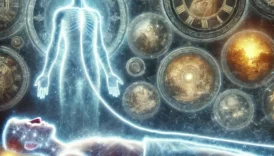Pineal Gland Calcification
Have you ever felt mentally foggy, had irregular sleep, or felt like the connection with your inner guidance has weakened? In the hustle and bustle of modern life, such feelings are quite common. But what if we told you this situation might be related to a tiny, pinecone-shaped organ located right in the center of our brain – the pineal gland? Scientifically tasked with secreting our sleep hormone, melatonin, this gland has also been regarded in many ancient cultures as the “third eye,” the center of our intuition and inner wisdom. However, certain factors we are exposed to in the modern world can lead to a type of buildup on this sensitive organ called calcification. This “invisible burden” can affect both our biological rhythms and perhaps deeper perceptions we might not even be aware of. In this article, we will look behind the curtain of pineal gland calcification, examine its possible causes (yes, including fluoride!) and potential effects in a sincere tone, and most importantly, explore practical and holistic methods for preventing or reducing its impact. Our aim is to help you recalibrate your inner compass.
- Pineal Gland Calcification
- Our Mysterious Inner Compass: What is the Pineal Gland?
- What is Pineal Gland Calcification?
- Why Does Pineal Gland Calcification Occur?
- What are the Effects of Pineal Gland Calcification?
- Preventing and Reducing Calcification in the Pineal Gland: Methods
- A Journey, Not a Destination: Patience and Holism
- Conclusion: Recalibrating Your Inner Compass is Possible
Our Mysterious Inner Compass: What is the Pineal Gland?
First, let’s get acquainted with our protagonist. The pineal gland is a tiny (about the size of a pea) but functionally significant organ strategically located in the center of our brain, between the two hemispheres. It gets its name from its pinecone-like shape (Latin: pinea). Its most well-known and scientifically proven function is producing the hormone melatonin based on the light information it receives from the environment. As darkness falls, melatonin secretion increases, signaling sleepiness and managing our body’s natural sleep-wake cycle (circadian rhythm). It’s also a powerful antioxidant and immune system supporter.
But what makes the pineal gland so intriguing isn’t just its biological role. Unlike many structures in the brain, it’s singular, not paired, and its central location has shrouded it in mystery throughout history. From Descartes defining it as the “seat of the soul” to the concept of the “third eye” (Ajna Chakra) in Eastern philosophies, many beliefs associate this gland with perceiving beyond the physical world, intuition, and higher consciousness. That’s why the issue of calcification, which could affect its health, is significant not just for our sleep patterns but for our holistic health and potential.
What is Pineal Gland Calcification?
So, what exactly is this calcification? It’s actually quite a simple process: the accumulation of calcium phosphate crystals within the tissue of the pineal gland. This isn’t unique to the pineal gland; calcification can occur elsewhere in the body (like in arteries or joints). Pineal gland calcification is quite common and tends to increase, especially with age. Autopsy studies have shown some level of calcification even in young individuals.
“But if it’s normal, why worry?” you might ask. The concern stems from two main points:
- Impact on Melatonin Production: It’s thought that as calcification intensifies, the pineal gland’s primary function of producing melatonin might decrease or become irregular. This can directly affect our sleep quality, mood, and overall health.
- Impact on “Third Eye” Functions (Speculative): For those looking from a spiritual and esoteric perspective, calcification is seen as a “veil” or “blockage” hindering intuitive perception, spiritual connection, and inner clarity. Combined with theories that this gland might be sensitive to electromagnetic fields, it’s thought that calcification could reduce this sensitivity. (While this part isn’t scientifically proven, it’s a significant concern for those taking a holistic view.)
In short, calcification emerges as a condition that could potentially disrupt both scientifically established biological functions and functions believed to be more subtle and intuitive.
Why Does Pineal Gland Calcification Occur?
Why does our pineal gland calcify? There’s no single answer; it’s more of a combination of factors. Unfortunately, some challenges of modern life can accelerate this process:
- The Fluoride Factor: This is perhaps the most discussed and debated cause. Fluoride is a mineral added to drinking water, toothpaste, and some foods to prevent tooth decay. However, research indicates that fluoride tends to accumulate in the body, particularly in bones and the pineal gland. The pineal gland is thought to be one of the tissues that accumulates the most fluoride in the body. There are strong suspicions and some scientific studies suggesting this accumulation forms calcium phosphate crystals, triggering or accelerating calcification. Still, it’s worth noting that scientific debate continues, and the exact extent of the effect is unclear.
- Dietary Habits:
- Excess Calcium: High doses of calcium supplements, especially without balancing factors like Vitamin D, Vitamin K2, and magnesium, or processed foods with excessive calcium, can cause calcium to deposit in the wrong places (like the pineal gland).
- Processed Foods: Additives, preservatives, artificial sweeteners, and refined sugars create a general inflammatory environment in the body. This can set the stage for many health problems, including calcification.
- Phosphorus Imbalance: Excessive phosphorus from sources like phosphoric acid found abundantly in sodas can disrupt calcium balance and contribute to calcification.
- Environmental Toxins: Heavy metals (like mercury, lead, aluminum) and pesticides we’re exposed to through the air we breathe, the food we eat, and the products we use can accumulate in our bodies, creating a toxic load and affecting the calcification process.
- Lifestyle Factors:
- Insufficient Sunlight: Natural sunlight is crucial for Vitamin D synthesis, which plays a role in proper calcium utilization. Insufficient sun exposure can disrupt this balance.
- Chronic Stress: Being under constant stress increases the release of stress hormones like cortisol. This can trigger inflammation and disrupt hormonal balance, indirectly affecting the pineal gland.
- Poor Sleep Habits: Irregular sleep schedules that disrupt the pineal gland’s natural rhythm, and exposure to blue light (from phone, tablet screens) before bed can also negatively impact the gland’s health.
- EMF Exposure (Potential): While concerns are raised about the potential negative effects of electromagnetic fields from sources like cell phones and Wi-Fi modems on the pineal gland, scientific evidence is still limited and debated.
- Aging: As mentioned earlier, calcification naturally tends to increase with the aging process.
The goal here isn’t to assign blame but to understand how modern life can unknowingly affect our internal balance and to become conscious of it.
What are the Effects of Pineal Gland Calcification?
What could be the potential effects of pineal gland calcification? These effects can vary from person to person and often overlap with other health issues, making it difficult to provide a definitive list of “calcification symptoms.” However, both scientific observations and personal experiences suggest potential impacts in these areas:
- Biological Effects (More Established):
- Sleep Problems: This is the most frequently associated effect. Disrupted melatonin production can lead to difficulty falling asleep, frequent waking during the night, poor sleep quality, and waking up tired.
- Circadian Rhythm Disorders: Disruption of the body’s internal clock can lead to feeling constantly tired or “jet-lagged,” mood swings, and susceptibility to seasonal depression.
- Headaches (Possible Link): In some cases, a link between headaches and pineal gland issues, especially cysts or large calcifications, is considered, though this is less common.
- Speculative / Spiritual Effects (Often Mentioned):
- Reduced Intuition: Difficulty hearing one’s inner voice, a dulling of the “sixth sense,” inability to remember dreams, or dreams losing their vividness.
- Spiritual Disconnection: Difficulty meditating or going deep, a weakened sense of connection to the universe or a creative force.
- Lack of Creativity and Inspiration: Difficulty generating new ideas, artistic blocks, limited imagination.
- General Feeling of Being “Stuck”: Inability to move forward in life, feeling directionless, mental fog, and difficulty concentrating.
Important Note: Many of these symptoms can have numerous other causes (stress, nutritional deficiencies, other health problems, etc.). What’s important here is to listen to your own body, notice the changes you experience, and evaluate them holistically. Pineal gland calcification could be a potential part of these symptoms.
Preventing and Reducing Calcification in the Pineal Gland: Methods
So, what can we do to get rid of or alleviate this “invisible burden”? The good news is that it might be possible to support pineal gland health and prevent or reduce calcification through conscious changes in our lifestyle and diet. This isn’t a magic wand fix; it’s a holistic approach requiring patience and consistency:
1. Diet is Key:
- Reduce Fluoride: Drink filtered or spring water if possible. Choose fluoride-free toothpaste. Avoid processed foods and beverages that may contain added fluoride (like some sodas).
- Eat Clean and Natural: Eliminate processed foods, refined sugars, artificial sweeteners, and trans fats from your diet. Consume plenty of fresh vegetables (especially dark leafy greens), fruits, whole grains, healthy fats (like olive oil, avocado, walnuts), and quality protein. Opt for organic foods when possible. An alkaline diet supports overall health.
- Supportive Foods and Nutrients:
- Iodine: Thought to help remove fluoride from the body. Seaweeds (kelp, nori) and seafood are natural sources. (Consult a doctor if considering supplements, as excess can be harmful.)
- Boron: Suggested to support fluoride excretion and calcium/magnesium balance. Avocado, prunes, almonds, hazelnuts, and raisins are good sources.
- Magnesium: A critical mineral for proper calcium utilization in the body. Leafy greens like spinach, pumpkin seeds, almonds, and dark chocolate (raw cacao) are rich in magnesium.
- Vitamin K2: Helps direct calcium to the bones, potentially preventing buildup in soft tissues (like the pineal gland). Fermented foods (especially natto), meat and dairy from grass-fed animals, and egg yolks contain K2.
- Activators/Detox Supporters (Belief-Based):
- Apple Cider Vinegar (Organic): Its malic acid content is thought to aid detox.
- Turmeric (Curcumin): A potent anti-inflammatory. Absorption is enhanced with black pepper.
- Raw Cacao: A source of magnesium and antioxidants.
- Chlorophyll: Sources like spirulina, chlorella, and wheatgrass may aid heavy metal detox.
- Drink Plenty of Water: Adequate intake of clean water is essential for the body’s natural detoxification processes.
2. Lifestyle Changes:
- Embrace the Sun: Safe sun exposure for 15-20 minutes daily (especially morning/late afternoon) supports Vitamin D levels and your circadian rhythm.
- Manage Stress: Remove stress from your life using methods like meditation, yoga, deep breathing exercises, spending time in nature, or engaging in hobbies you love.
- Practice Good Sleep Hygiene: Try to go to bed and wake up around the same time each day. Ensure your bedroom is dark, quiet, and cool. Avoid blue light sources like phones and tablets at least 1-2 hours before bed.
- Reduce Toxin Exposure: Try to use natural products for home cleaning and personal care. Avoid cigarette smoke and air pollution as much as possible.
- Detox Practices (Optional/Careful): Activities that induce sweating, like exercise or sauna use, can help the body eliminate toxins. However, consult a professional before undertaking intensive detox programs.
3. Supplements (Under Doctor’s Supervision):
You might consider supplements for Magnesium, Vitamin K2, Iodine, Boron, or Vitamin D if you suspect dietary intake is insufficient. However, before starting any supplement, always consult your doctor or a nutrition expert to determine your needs and the correct dosage. Using supplements improperly can do more harm than good.
A Journey, Not a Destination: Patience and Holism
The process of decalcifying the pineal gland (if possible) is not something that happens overnight. It’s a long-term journey requiring patience, consistency, and, most importantly, self-compassion. Instead of focusing on a single “miracle” cure, taking holistic steps to improve your overall health is the most sensible approach.
Remember, the goal isn’t just to “cleanse” the pineal gland but to become a healthier, more energetic individual who is more connected to their inner world. Listen to the signals your body sends, start with small steps, and don’t hesitate to seek support from healthcare professionals on this journey.
Conclusion: Recalibrating Your Inner Compass is Possible
Pineal gland calcification might be a reflection of the challenges posed by modern life. However, this doesn’t mean we are helpless. By paying attention to our diet, making conscious lifestyle changes, and supporting our body’s natural balance, we can protect the health of this small but important organ. Every step we take—from avoiding fluoride to embracing natural foods, from staying away from stress to reconnecting with the sun—is an investment not just in our pineal gland but in our entire body and spirit.
This is a journey of recalibrating our inner compass, regulating our biological rhythms, and perhaps awakening the intuitive potential that lies dormant within. Be kind to yourself, trust the process, and enjoy taking steps towards a clearer, healthier life.





